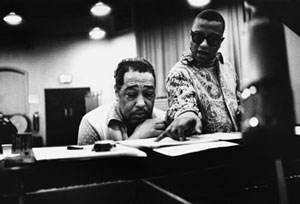
Overview
In the evolution of jazz, the New Orleans and Chicago styles of the 1920s gave way to the emerging swing style of the 1930s. In this, and the next several sections, we will learn about some of the most influential jazz musicians of this era and how their musical contributions helped shape the jazz style known as swing.
Objectives
Upon completion of this lesson, you will be able to do the following:
- Identify selected swing musicians and their contributions to jazz
- Define charts
- Identify the significance of call-and-response in Fletcher Henderson's compositions, as well as in others‘
- Define antiphonal counterpoint
The "Ellington Effect"
Ellington's genius was multi-faceted: musician, bandleader, arranger, and composer. His musical instrument was the piano. While his piano skills were based largely having studied the piano rolls of stride-style pianist James P. Johnson, Ellington's style was more economical than stride and his harmonies more "lush."
As bandleader, Ellington had an extraordinary knack for utilizing the distinctive sounds of his sidemen in his charts. From the time of his arrival in New York, he had been gradually building the size of his band with selective additions of instrumentalists.These were not necessarily the most obviously talented players, but each man brought with him a musical personality and character that Ellington could blend into a musical whole unlike that of any other band. When Ellington composed a piece or arranged his charts, he always had his individual players in mind. Billy Strayhorn, who would later become Ellington's protégé, astutely observed:
" Ellington plays the piano, but his real instrument is his band. Each member of his band is to him a distinctive tone color and set of emotions, which he mixes with others equally distinctive to produce a third thing, which I like to call the Ellington Effect A term coined by Billy Strayhorn to describe the originality and distinctiveness of the sound of the Duke Ellington Orchestra, attributable to Ellington’s brilliance as a composer and arranger, to the individually distinctive sounds of his sidemen, and to the ways in which Ellington wrote specifically for them10.
Ellington had a fascination with exotic sounds, and his charts displayed unique orchestral colors. He achieved this effect by making use of voicing across sections, as well as sometimes placing instrumental lines outside their normal ranges, occasionally inverting the expected arrangement of pitches among the instruments.
Ellington's gift as a composer set him above all others. His ability to collaborate with his sidemen and draw compositional ideas from them was integral to this process. Ultimately, it was Ellington the composer who realized his compositional vision in the band's performances—and achieved the "Ellington Effect."



Billy Strayhorn's last composition was "Blood Count" (originally titled "Blue Cloud"), written during his battle with cancer. Duke Ellington debuted it at a concert in Carnegie Hall in March 1967 and never played it publicly again.

